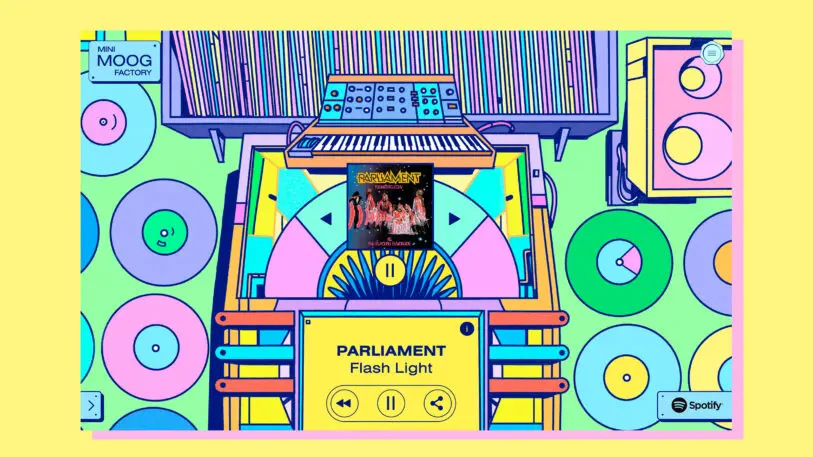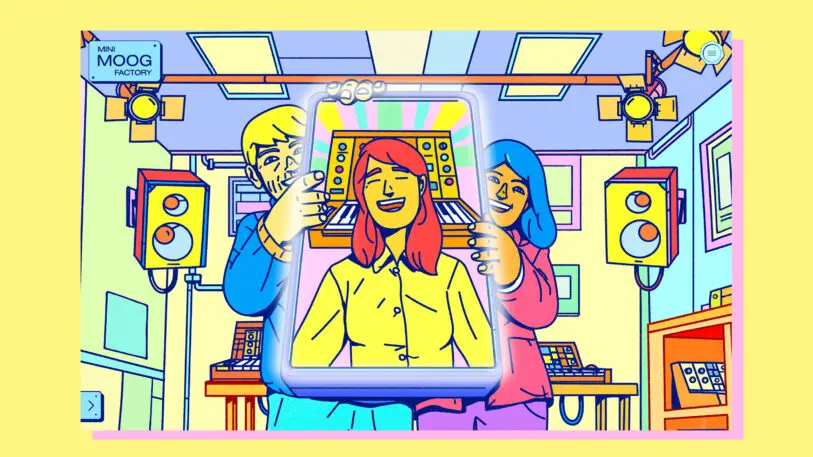Head to minimoogmodeld.com, my friends, because you are in for a trippy treat to celebrate the 70th anniversary of the Minimoog Model D, the iconic instrument that brought synthesizer sounds to countless influential albums, including David Bowie’s Low, Bob Marley’s Catch a Fire, or Dr. Dre’s The Chronic.
Designed by Pentagram partner Yuri Suzuki, the mini site—called the Minimoog Model D Factory—features an interactive eight-room house in which every chamber leads to a different experience, including a virtual Minimoog Model D that you can automatically adjust to distill the sounds used in different famous songs that span decades, styles, and creators, including Air and Frank Zappa.

For Suzuki, whose expertise in sound and instrument design has led to the creation of many wonderful sound machines, the Minimoog Model D means a lot to him. “It’s the first synthesizer accessible by many musicians for its portability and its cleverly simplified sound-making system,” he tells me via email. Its influence can’t be understated, so Suzuki wanted to create an experience that would invite everyone—not only Moog enthusiasts—to discover why the Minimoog D is so special. “I wanted to tell the world about Dr. Moog’s achievement,” he says.
The site had to be as simple and fun to play with as the Model D itself. Suzuki is dyslexic and has difficulty spending long periods reading and watching long videos, so he thought that the easiest way to learn would be through play. To that end, he found inspiration in late ’80s and early ’90s interactive computer games.
“My first inspiration was an early Macintosh game called Manhole, which allowed you to discover a world made with Hypercard,” Suzuki says. Created by Bill Atkinson (the interface developer behind the Lisa, Apple’s first personal desktop computer with a graphical-user interface), Hypercard pioneered the concept using hyperlinks to tell stories and present information in a visual way. (This concept paved the way for the World Wide Web and shaped our current electronic user experience.) With its layered design, the Minimoog site certainly has the Hypercard spirit in it.
Suzuki’s second reference was an early CD-ROM game called L-Zone, created by Japanese computer-graphics artist and video-game director Haruhiko Shono. In L-Zone, players explore a virtual city to find machines and contraptions that they can play with to help solve a mystery. But his biggest reference by far was the classic cult game Maniac Mansion, the first graphic adventure hit created by Ron Gilbert for Lucasfilm Games, in which players can choose their own adventure by wandering through an 8-bit mansion filled with surprises.
Eight funky rooms
The site doesn’t go as far as creating a full Maniac Mansion graphic adventure experience (I wish!). Instead of a full game, Suzuki created a colorful doll house with eight rooms loaded with a Where’s Waldo-esque menagerie of people dancing, partying, and doing Moog-y things. Like an Advent calendar, you click on each of these rooms to reveal a feature inside. The interface zooms into the house and a hand appears to open a door into the room.
Starting from the bottom left, the first room leads you to an Instagram filter that allows you to create Moog sounds using your own face. The second gives you a PDF with plans to build your own paper Minimoog D. The third is a theater in which to watch a three-part mini-documentary on the history of the instrument and the many artists who used it. The last room on the first floor leads you to the Minimoog D app (sadly, you will have to pay $30 for it).

While Suzuki certainly made a fun and approachable website, I wish it had more depth to it. In each room, I found myself wanting to click around to uncover Easter eggs and mini-games, like you do in the references he names as inspiration. I personally wanted this wacky, trippy world of Dr. Moog definitely to be more wacky and trippy, but I recommend it anyway, if only to pretend you are Giorgio Moroder banging away on a historic synth in the Moog Mansion’s practice room.
Recognize your brand’s excellence by applying to this year’s Brands That Matter Awards before the early-rate deadline, May 3.